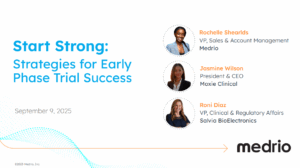Contributing Expert: Rod McGlashing, Data Science Subject Matter Expert
An Electronic Data Capture (EDC) system is at the forefront of technological evolution in clinical trials. Undoubtedly, clinical research is shifting towards greater decentralization, further globalization, increasing data endpoints, and more complex protocols.
With pressure to improve efficiency and data quality, research teams are searching for the right solutions. Electronic Data Capture systems for clinical trials can set teams up to build faster, more robust trials.
Here’s what you can learn from this article:
- What is an Electronic Data Capture (EDC) system
- Why people use EDC software in clinical trials
- Who uses EDC software
- What EDC systems support
- Benefits of an EDC
- Key Features of EDC Systems
- How to choose an EDC partner
- Answers to frequently asked questions
Want to learn more about what to look for in an EDC and its vendor? Explore our buyer’s guide, “Finding the Right EDC Solution for Your Next Clinical Trial.”
What Is EDC in Clinical Trials?
An Electronic Data Capture system or EDC in clinical trials collects clinical trial data. It is typically part of a broader system called a Clinical Data Management System (CDMS) that manages and stores clinical trial data. EDC software improves data accuracy, trial efficiency, and data integrity in clinical research.
A CDMS/EDC is an essential part of clinical operations and aids in the data collection process, lab management, medical coding, data review, data cleaning, query management, and risk management.
Why Use EDC Software in Clinical Trials?
An EDC system was originally created to digitize paper-based case report forms (CRFs). Today, EDCs are no longer merely data entry systems for sites. This technology is transforming to support the growing complexity and speed of clinical research.
Beyond a single point of direct data capture, Electronic Data Capture systems can now absorb a huge range of data sources coming from many places at different times. In fact, EDCs are evolving into true clinical data management systems (CDMS).
These systems can support the end-to-end management of clinical trial data, including:
- Data collection
- Data review
- Data cleaning
- Validation
- Reporting
While electronic data capture is important, a CDMS may include features beyond data capture.
Want to better understand the advantages of digital data capture over traditional methods? Read our detailed comparison of ePRO vs paper strategies.
Who Uses EDC Software for Clinical Trials?
Electronic Data Capture software is critical in modern clinical trials, enabling efficient data collection, management, and analysis. It is an essential tool for improving regulatory compliance, data quality, and study timelines.
The primary users of EDC software are:
- Sites: Clinical research sites use EDC to collect and submit trial data in real time. This ability supports data accuracy and faster reporting to sponsors and CROs.
- Sponsors: Sponsors leverage EDC for centralized access to trial data. This ability enables better monitoring, analysis, and decision-making.
- Contract research organizations (CROs): CROs use EDC to manage data across multiple trials and sites. This ability supports efficiency, regulatory compliance, and seamless collaboration with sponsors.
What Should an EDC Support?
Every study is unique, so the right mix of purpose-built technologies can look different for each one. There are some basics, however, that every study needs for its success.
Your CDMS/EDC solution should support the following:
- Secure, real-time access to clinical trial data
- Efficient data capture options with onsite and remote capabilities
- Simple mid-study updates
- Consolidated reporting with dynamic reports and easy data exports
- Seamless integration of third-party data sources
- Comprehensive data and privacy protection features
The right Electronic Data Capture system should help sponsors, CROs, and sites achieve speed, ensure data quality, maintain control, and create seamless workflows.
Download our EDC Buyer’s Guide
Discover what to look for in an electronic data capture system to realize the full benefits. Ready to run faster, higher-quality clinical trials? Explore our EDC Buyer’s Guide.
Benefits of Electronic Data Capture Systems
Not all Electronic Data Capture systems are the same. But EDC systems with an intuitive design and flexible functionality can enable efficient, higher-quality clinical trials.
An intuitive EDC partner can help you:
- Accelerate clinical trial timelines. Speed up trials with quick builds, standard forms, reusable templates, and seamless mid-study updates.
- Support flexible and varied workflows. Customize workflows to match unique trial needs and complexities.
- Maximize operational efficiency. Eliminate redundancies and automate tasks to save time and resources.
- Capture high-quality data. Reduce errors and ensure accuracy with well-configured edit checks and query management tools.
- Ensure regulatory compliance. Stay audit-ready with systems designed to meet global regulatory standards.
- Maintain submission-ready data. Simplify regulatory submissions with consistent formatting and complete datasets.
- Improve data accessibility. Provide stakeholders with centralized, easy-to-navigate data based on their unique needs.
- Make strategic decisions with real-time data. Access live dashboards and retrieve dynamic reports seamlessly.
- Enhance data integrity. Maintain clean, reliable data with robust security and audit trail features.
- Optimize data analysis. Leverage advanced reporting and data exports for deeper insights and actionable outcomes.
- Scale clinical trial efforts. Seamlessly expand capabilities to handle large datasets, run more studies, or add more sites.
- Transition between study phases. Quicker study builds based on form templates can improve transition times between study phases.
Accelerate clinical trial timelines
Overly complicated database builds can slow a study down before it’s even begun. Balancing the need for speed with comprehensive data collection is essential to ensure the trial’s success and avoid future delays.
To achieve greater speed, choose an EDC with an intuitive design and flexible functionality. Standard forms and reusable templates can speed up study builds and support future scalability. Meanwhile, seamless mid-study updates can further accelerate clinical trial timelines.
Improve clinical trial data quality
The importance of quality clinical trial data cannot be overstated. Maintaining data quality and control is key to receiving regulatory approval.
The right EDC solution supports data quality through edit checks and further data validation methods. It should also offer consistent formatting and pre-built forms based on industry standards. Regulators focus on data integrity, so sponsors also need an EDC with advanced data security features.
Maximize operational efficiency
As clinical trials decentralize, the ability to collect electronic data from various sources is important for operational efficiency. The right EDC empowers sponsors to make decisions with real-time data and supports varied workflows.
A good solution will also simplify transitioning between study phases and support scalability.
An Electronic Data Capture system that integrates with other technology is critical to support traditional, hybrid, or decentralized clinical trial workflows and maximize operational efficiency. EDCs can also support studies gathering real world data.
To learn more, read our success story, “How MAC Clinical Research Innovates with Medrio CDMS/EDC.”
Key Features of EDC Systems
Modern EDC systems come with features to simplify and enhance clinical trial management. These tools streamline workflows, improve data quality, and ensure regulatory compliance.
The right EDC features allow sponsors and CROs to focus on delivering results faster and more efficiently.
Key features of an EDC include:
- Configurable, point-and-click builds: Quickly build studies with drag-and-drop tools, no coding required.
- Customizable user administration: Assign roles and permissions to match your team’s needs.
- Pre-built study template library: Start your study faster with templates for common study designs.
- Study and form copy functionality: Save time by reusing existing studies or forms for new trials.
- Data carry: Seamlessly transfer data across visits or forms to reduce duplication.
- Edit checks and queries: Automate data validation with built-in rules and query workflows.
- Multi-tiered production and validation environments: Build, test, and live environments support efficient testing and implementation of database changes.
- Real-time data access: View up-to-date data instantly for better decision-making.
- Targeted monitoring workflows. Focus efforts on high-risk or critical data points.
- Dynamic, custom reporting. Generate tailored reports to meet specific stakeholder needs.
- Global regulatory compliance: Ensure trials meet data and safety standards.
- Flexible data export options: Export data in various formats for analysis or submission.
- Single-click submission casebooks: Compile and submit trial data with one simple action.
Choosing the Right EDC Partner
The clinical trial landscape is evolving. A 2021 analysis by the Tufts Center for the Study of Drug Development (CSDD) found that phase III clinical trials now generate 3.6 million data points on average—approximately three times more data points than a decade ago.
At the same time, more trials are embracing accelerated programs and blending multiple phases. This shift means future studies will include more sites, participants, data, arms, and mid-study changes.
With all these changes, choosing the right digital tools and partners to support clinical trials is important.
A strategic EDC partner should support:
- API integrations: Connecting with other systems supports data flow and reduces manual work.
- Skip logic and edit checks: Automating data checks saves time when cleaning and analyzing data.
- Auto-generation of subject IDs: Unique participant IDs prevent duplication and make it easier to track them throughout the study.
- Dynamic rules: Flexible rules can automate complex tasks and keep data management consistent.
- Separate clinical and operational data: Keeping data types separate makes reporting easier.
- Custom and pre-built reporting modules: Personalized reports provide useful insights. Ready-made options save time for standard analyses.
- In-platform dashboards and data visualizations: Real-time visual insights help track progress, spot issues, and make it easy to share findings.
- Real-time data access and on-demand extracts: Instant access to data supports faster decision-making and adjustments.
- Permission-based reporting access: Only authorized people see sensitive data, keeping it secure and compliant.
Free CDMS/EDC eBook
Discover what small teams need in a strategic CDMS/EDC partner. Download our free eBook.
Need a Reliable EDC System? Choose Medrio!
More than just a data collection tool, Medrio’s intuitive EDC keeps you in control of your study—from database build to final reporting.
Medrio CDMS/EDC has advanced controls for improved data quality and regulatory readiness. Purpose-built for ease of use and efficiency, our solution ensures you can confidently conduct your study. The best part? Our unrivaled expert support and adherence to compliance standards guarantee your data is in safe hands.
Connect with our team.
Explore how Medrio can support your trials. Schedule a demo today!
Frequently Asked Questions about an EDC in Clinical Research
Common questions about EDC solutions.
What is an Electronic Data Capture system?
An Electronic Data Capture (EDC) system is a digital system for collecting, managing, and storing electronic data during a clinical trial.
How does EDC software collect data?
EDC software collects data through electronic case report forms (eCRFs). Sites input study-specific data directly into the system through eCRFs. Many EDCs also integrate with devices like wearables, ePRO, and lab systems for automatic data capture. Integration supports accurate, real-time data collection while minimizing errors.
How is data exported in EDC systems?
Data in EDC systems is exported using flexible file options, allowing easy integration with analysis tools. Advanced features like customizable export settings and single-click casebooks ensure datasets are submission-ready, compliant, and tailored to specific study or regulatory requirements.
What is the difference between EHR and EDC?
EHR stands for electronic health record, which is a digitized version of patient medical records. EDC stands for electronic data capture, which is digital data captured during a clinical trial.
What is an example of EDC data?
A few examples of EDC data could be patient demographic information, bloodwork, symptom information, or any details about the treatment or condition being studied.
Who uses EDC systems?
Sponsors, contract research organizations (CROs), and research sites use EDC systems to collect and manage clinical trial data.



